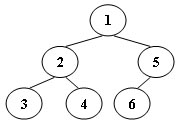An inorder binary tree traversal can be implemented in a non-recursive way with a stack. For example, suppose that when a 6-node binary tree (with the keys numbered from 1 to 6) is traversed, the stack operations are: push(1); push(2); push(3); pop(); pop(); push(4); pop(); pop(); push(5); push(6); pop(); pop(). Then a unique binary tree (shown in Figure 1) can be generated from this sequence of operations. Your task is to give the postorder traversal sequence of this tree.
Figure 1
Input Specification:
Each input file contains one test case. For each case, the first line contains a positive integer N (≤30) which is the total number of nodes in a tree (and hence the nodes are numbered from 1 to N). Then 2N lines follow, each describes a stack operation in the format: "Push X" where X is the index of the node being pushed onto the stack; or "Pop" meaning to pop one node from the stack.
Output Specification:
For each test case, print the postorder traversal sequence of the corresponding tree in one line. A solution is guaranteed to exist. All the numbers must be separated by exactly one space, and there must be no extra space at the end of the line.
Sample Input:
6
Push 1
Push 2
Push 3
Pop
Pop
Push 4
Pop
Pop
Push 5
Push 6
Pop
Pop
Sample Output:
3 4 2 6 5 1#include<cstdio>
#include<iostream>
#include<string>
#include<stack>
using namespace std;
int in[30] = {0},pre[30] = {0};
bool flag = true;
void postorder(int root,int start,int end){
if(start>end)
return;
int i = start;
while(i<end && in[i] != pre[root] ) i++;
postorder(root+1,start,i-1);
postorder(root+1+i-start,i+1,end);
printf("%s%d",flag==true?"":" ",pre[root]);
flag = false;
}
int main(){
stack<int> s;
int n,root,a,j=0,k=0;
string str;
cin>>n;
for(int i=0;i<2*n;i++){
cin>>str;
if(str.length()==4){
cin>>a;
s.push(a);
pre[k++] = a;
}else{
in[j++] = s.top();
s.pop();
}
}
postorder(0,0,n-1);
}
